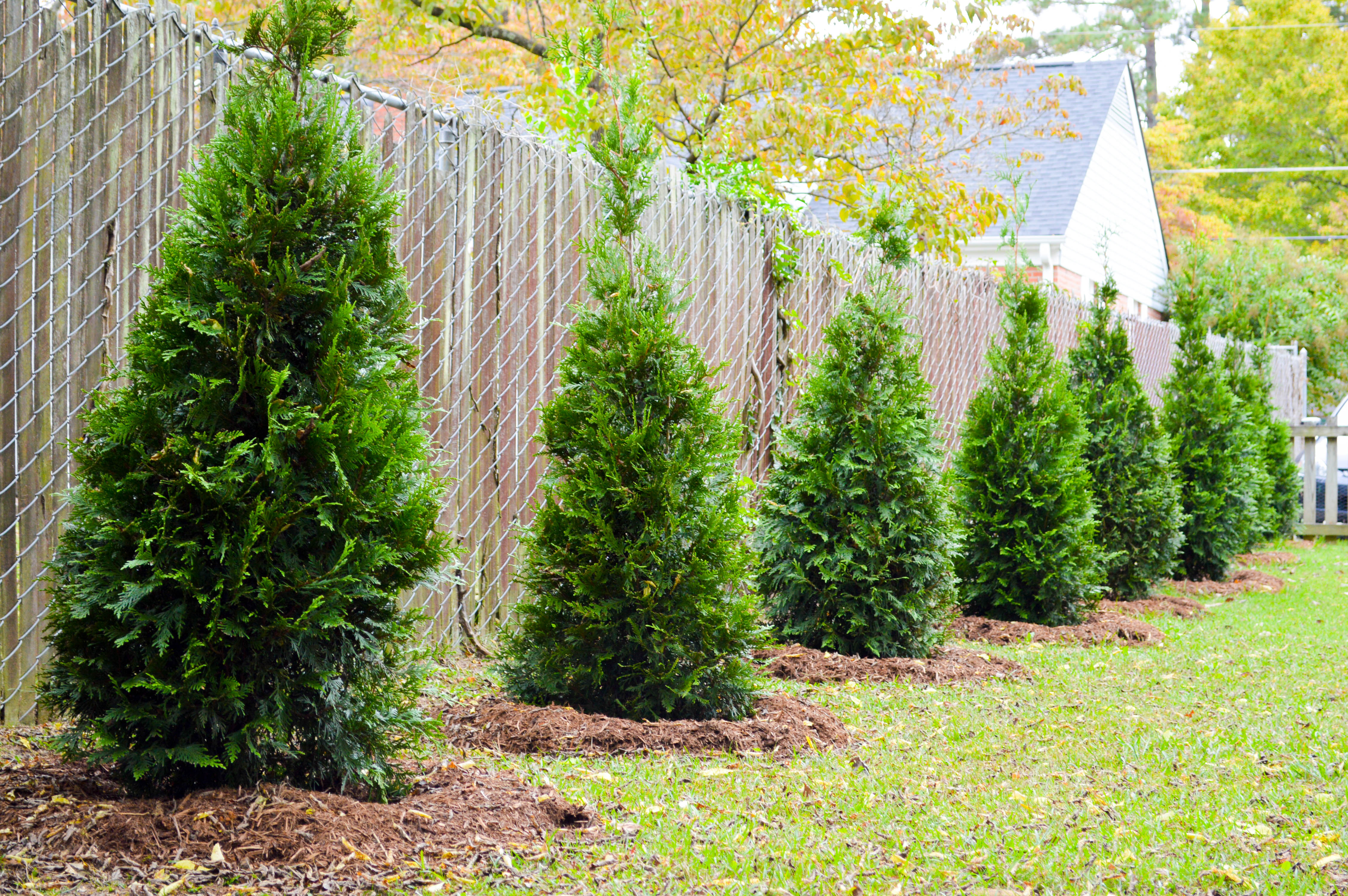Plant this deciduous tree along property lines for a nice spring/summer grouping of privacy trees and windbreaks. Some privacy trees are also pest and disease resistant.
Trees To Plant For Privacy, It is deciduous, but when it sheds all leaves in fall, it displays a bright seasonal thicket of red branches. Works well as a temporary privacy tree and windbreak;

An increasing number of people are choosing privacy trees over fences when it comes to enjoying their property. Heat tolerant or cold hardy. However, many fruit trees are sold on a dwarf rootstock, so check the eventual height before buying. Where to plant privacy trees or plants;
Focus on spacing and recognize that the closer you plant your trees, the sooner they grow together to create a continuous hedge.
This is great for keeping the feeling of the garden open, yet blocking off unsightly views at eye level. Soft, lush evergreen foliage characterizes this screen tree. Trimming, pruning, and clipping privacy hedges; What are the best privacy trees? Cultivate in areas of full sun with well. Get started with your own privacy trees or gardening supplies by shopping here for gardening best sellers.
 Source: prettypurpledoor.com
Source: prettypurpledoor.com
Heat tolerant or cold hardy. Although these drought tolerant trees prefer full sun, they can grow in partial shade as well. Some privacy trees are also pest and disease resistant. Their speedy growth rate, allowing for quicker privacy protection, is why many choose this tree. Read 5 tips to landscape with trees
 Source: pinterest.co.uk
Source: pinterest.co.uk
They all have advantages so your choice may depend on a number of factors. This plant privacy idea from ‘ ivy clad ‘ is using the technique of “pleaching”. Evergreens with large foliage or evergreen conifers with branches that extend to the ground are the most useful for privacy. Each tree will need a distinct growing. The most popular privacy.
 Source: pinterest.co.kr
Source: pinterest.co.kr
Usually planted for very fast privacy screens. Of course, evergreen trees are usually the most sought after when it comes to creating a privacy fence. The syzygium smithii (formerly acmena smithii) grows up to five metres tall relatively quickly. Matures to a height of 40 to 60 feet and a width of 10 feet. Where to plant privacy trees or.
 Source: hortzone.com
Source: hortzone.com
Plant this deciduous tree along property lines for a nice spring/summer grouping of privacy trees and windbreaks. Depending on where you live you may want to select a green screen that is. Evergreens with large foliage or evergreen conifers with branches that extend to the ground are the most useful for privacy. Usually planted for very fast privacy screens. But.
 Source: greenearth-landscapes.com
Source: greenearth-landscapes.com
Evergreens with large foliage or evergreen conifers with branches that extend to the ground are the most useful for privacy. To create even more screening in a space, you can create two or more rows of staggered trees (see image). In this group we have all the familiar evergreens like pine, cedar and cypress. Of course, evergreen trees are usually.
 Source: yourhomesecuritywatch.com
Source: yourhomesecuritywatch.com
But deciduous trees can add landscaping elements like spring flowers or fall colors. Each tree will need a distinct growing. One of the most resilient trees, the thuja green giant is one of the most popular privacy trees for backyard landscaping. Lilly pillys have been a common choice for privacy in australian gardens for decades. It is deciduous, but when.
 Source: greensideupgifts.com
Source: greensideupgifts.com
Soft, lush evergreen foliage characterizes this screen tree. Their speedy growth rate, allowing for quicker privacy protection, is why many choose this tree. Heat tolerant or cold hardy. Technically, it�s a shrub, but the nellie stevens holly towers high, reaching 25 feet when it�s fully grown. Apparently around since ancient times, pleaching involves weaving the overhead branches of plants together.
 Source: truesdalelandscaping.com
Source: truesdalelandscaping.com
A tree for screening needs to be allowed to get bigger than a normal fruit tree. Works well as a temporary privacy tree and windbreak; Choosing fast growing privacy trees. However, many fruit trees are sold on a dwarf rootstock, so check the eventual height before buying. Their speedy growth rate, allowing for quicker privacy protection, is why many choose.
 Source: plantingtree.com
Source: plantingtree.com
Unless there is one single angle that you hope to screen, the chances are you will need to plant multiple trees to create the privacy you need. Evergreens with large foliage or evergreen conifers with branches that extend to the ground are the most useful for privacy. However if you only need privacy during the warmer months when you use.
 Source: pinterest.com
Source: pinterest.com
Each tree will need a distinct growing. One of the most resilient trees, the thuja green giant is one of the most popular privacy trees for backyard landscaping. Soft, lush evergreen foliage characterizes this screen tree. Plant this deciduous tree along property lines for a nice spring/summer grouping of privacy trees and windbreaks. Lilly pillys have been a common choice.
 Source: blogarama.com
Source: blogarama.com
They all have advantages so your choice may depend on a number of factors. An increasing number of people are choosing privacy trees over fences when it comes to enjoying their property. Cultivate in areas of full sun with well. This plant privacy idea from ‘ ivy clad ‘ is using the technique of “pleaching”. Where to plant privacy trees.
 Source: bobvila.com
Source: bobvila.com
But deciduous trees can add landscaping elements like spring flowers or fall colors. It is deciduous, but when it sheds all leaves in fall, it displays a bright seasonal thicket of red branches. There are four main types of plants used for privacy. Lilly pillys have been a common choice for privacy in australian gardens for decades. You might also.
 Source: westchestertreelife.com
Source: westchestertreelife.com
What are the best trees for privacy? Choosing fast growing privacy trees. Heat tolerant or cold hardy. But deciduous trees can add landscaping elements like spring flowers or fall colors. Read 5 tips to landscape with trees
 Source: bowerandbranch.com
Source: bowerandbranch.com
It is deciduous, but when it sheds all leaves in fall, it displays a bright seasonal thicket of red branches. Unless there is one single angle that you hope to screen, the chances are you will need to plant multiple trees to create the privacy you need. In this group we have all the familiar evergreens like pine, cedar and.
 Source: mymove.com
Source: mymove.com
Focus on spacing and recognize that the closer you plant your trees, the sooner they grow together to create a continuous hedge. You might not think of this shrub as a privacy plant, but it�s lovely planted in a cluster or loose row. This is great for keeping the feeling of the garden open, yet blocking off unsightly views at.
 Source: prettypurpledoor.com
Source: prettypurpledoor.com
A tree for screening needs to be allowed to get bigger than a normal fruit tree. Trimming, pruning, and clipping privacy hedges; This tree has a conical yet feathery shape, excellent for blocking intrusions from above, as well as below. What are the best privacy trees? A fast growing privacy tree, the green giant arborvitae creates a seamless tree fence.
 Source: correctlydesign.com
Source: correctlydesign.com
In this group we have all the familiar evergreens like pine, cedar and cypress. This is great for keeping the feeling of the garden open, yet blocking off unsightly views at eye level. Of course, evergreen trees are usually the most sought after when it comes to creating a privacy fence. To create even more screening in a space, you.
 Source: prettypurpledoor.com
Source: prettypurpledoor.com
Choosing fast growing privacy trees. Matures to a height of 40 to 60 feet and a width of 10 feet. Planting screen trees close together may initially make sense, but this can result in lanky, sparse branching, rather than the lush, full branching you want for privacy. An increasing number of people are choosing privacy trees over fences when it.
 Source: plantsforallseasons.com
Source: plantsforallseasons.com
Cultivate in areas of full sun with well. Focus on spacing and recognize that the closer you plant your trees, the sooner they grow together to create a continuous hedge. Eastern arborvitae (thuja occidentalis)—this evergreen is another common tree used for privacy screens. Apparently around since ancient times, pleaching involves weaving the overhead branches of plants together so that they.
 Source: yourhomesecuritywatch.com
Source: yourhomesecuritywatch.com
One of the most resilient trees, the thuja green giant is one of the most popular privacy trees for backyard landscaping. Unless there is one single angle that you hope to screen, the chances are you will need to plant multiple trees to create the privacy you need. It also produces small pink berries that can be used in jams..
 Source: faddegons.com
Source: faddegons.com
Almost any soil can foster the growth of this beautiful privacy plant. Some privacy trees are also pest and disease resistant. This plant privacy idea from ‘ ivy clad ‘ is using the technique of “pleaching”. Top 10 flowering (and fruiting) trees for small gardens take a look at our advice on screening plants creating and maintaining living structures. This.
 Source: bobvila.com
Source: bobvila.com
Matures to a height of 40 to 60 feet and a width of 10 feet. There are four main types of plants used for privacy. The best trees for privacy are generally evergreen trees. Trimming, pruning, and clipping privacy hedges; Evergreens with large foliage or evergreen conifers with branches that extend to the ground are the most useful for privacy.
 Source: yourhomesecuritywatch.com
Source: yourhomesecuritywatch.com
This is very important since you are likely to plant many trees when creating a privacy hedge. Choose evergreen trees that are hardy and drought tolerant. Eastern arborvitae (thuja occidentalis)—this evergreen is another common tree used for privacy screens. What are the best privacy trees? But deciduous trees can add landscaping elements like spring flowers or fall colors.
 Source: mygardenlife.com
To create even more screening in a space, you can create two or more rows of staggered trees (see image). The best privacy trees will offer a fast rate of growth. Trimming, pruning, and clipping privacy hedges; Planting screen trees close together may initially make sense, but this can result in lanky, sparse branching, rather than the lush, full branching.
 Source: trexfurniture.com
Source: trexfurniture.com
In this group we have all the familiar evergreens like pine, cedar and cypress. There are four main types of plants used for privacy. Plant this deciduous tree along property lines for a nice spring/summer grouping of privacy trees and windbreaks. Cultivate in areas of full sun with well. Each tree will need a distinct growing.








